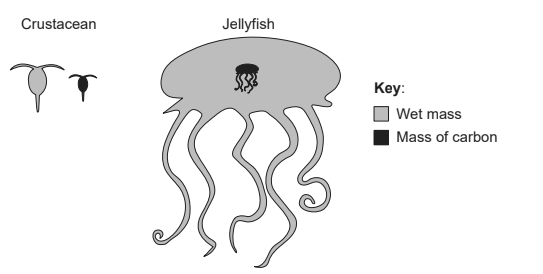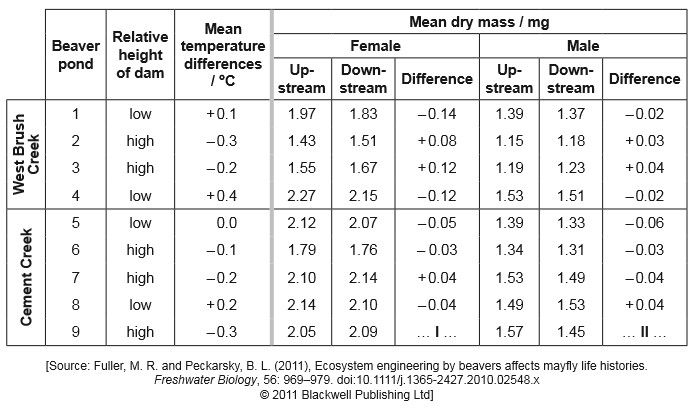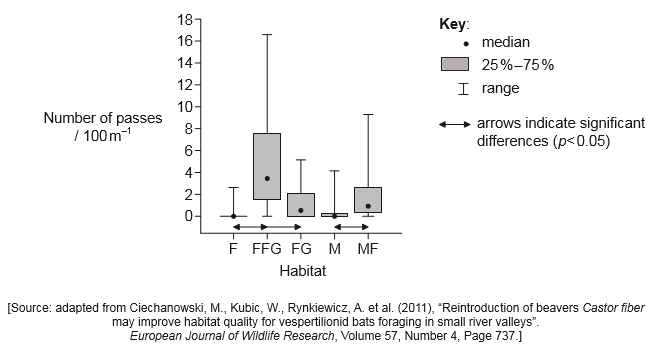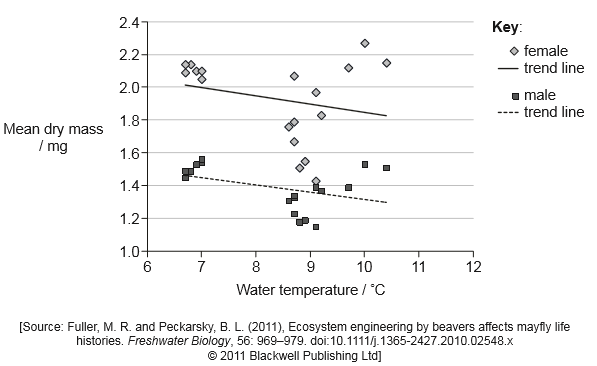Question
The mass of an individual organism can affect its physiology and feeding ecology. The diagram shows the relative mass of carbon (black) and total wet mass (grey) of a marine crustacean, Calanus hyperboreus and a jellyfish, Bathocyroe fosteri.

(a) State one process that results in the loss of carbon dioxide from a marine organism such as a crustacean or a jellyfish. [1]
(b) The crustacean and the jellyfish obtain carbon compounds by feeding. State one source of carbon for marine organisms, other than feeding. [1]
(c) Explain how energy enters, flows through and is lost from marine food chains. [3]
(d) (i) Deduce whether jellyfish or crustacea are a richer source of carbon in a food chain. [1]
(ii) Suggest with a reason whether having a large body mass is an advantage or disadvantage for jellyfish. [1]
▶️Answer/Explanation
Ans:
a
a. (aerobic/cellular) respiration
b. gas exchange / diffusion Do not accept photosynthesis. Do not accept breathing Organism is taken to be a living thing.
b
a. photosynthesis
b. absorption of (dissolved) carbon dioxide / (hydrogen)carbonate directly from the oceans Accept reference to carbonate or hydrogencarbonate ions
c
a. light energy is converted to chemical energy (in carbon compounds/sugars) by photosynthesis
b. (chemical) energy (in carbon compounds) flows by means of feeding/through food chains/webs
c. only (approximately) 10% of energy is passed to the next trophic level
d. energy released as heat (by respiration)
e. energy is not recycled f. after death, energy may remain trapped as undigested detritus/fossils/fossil fuels
d i crustacean as they have more carbon per unit volume OR crustacean as jellyfish has little carbon per total body size OWTTE The conclusion must be supported from the information
given
d ii
a. advantage of large size is ability to eat /catch large prey
b. (advantage as) lower rates of predation of large jellyfish
c. (advantage as) can produce more reproductive cells
d. (disadvantage as) can move slower to escape from predators/capture prey
e. (disadvantage as) needs more energy/nutrients to maintain structure/move/grow
f. (disadvantage as) low surface area to volume ratio and thus possibly difficulty with materials/gas/nutrient exchange g. (disadvantage as) more prone to mechanical damage during storms Accept other reasonable answer. Must say advantage or disadvantage
Question
Beavers are large rodents that live in waterways throughout the northern hemisphere. Dams made by beavers change the temperature of the streams and affect the mayfly, Baetis bicaudatus. In the summer of 2008, beaver ponds in West Brush Creek and Cement Creek, Colorado, were studied to evaluate their impacts on mayflies. The study sites included streams flowing into (upstream) and out of (downstream) each beaver pond.

Mayflies, including the species B. bicaudatus, are aquatic insects that hatch and spend their larval stages in water emerging from the water as adults. Larger females produce an increased number of better quality eggs.
The table shows the mean temperature differences (downstream – upstream) and mean dry mass for female and male mayflies.

The bat, Pipistrellus nathusii, feeds on insects including mayflies. A study was undertaken in Poland to see the effect of European beavers (Castor fiber) on the activity of bats. Beaver activity can affect forests that are covered by trees and meadows that are covered by grasses and have no trees. The following habitats were studied:
- forest (F)
- flooded forest with canopy gaps created by beavers and flooding due to the presence of beaver dams (FFG)
- forest with canopy gaps created by beavers but no flooding (FG)
- meadow (M)
- meadow with flooding due to the presence of beaver dams (MF).
As bats feed they fly through the air catching insects. The number of feeding passes made by bats was counted. The graph shows differences in the bat activity between particular habitats.

Calculate the difference in the mean dry mass of mayflies upstream and downstream of Cement Creek pond 9 for female and male mayflies.

Describe the effect dams have on water temperature.
The graph shows the mean dry mass of mayflies relative to the water temperature in their habitats.

Using the graph, discuss evidence for the hypothesis that mayflies grow to greater dry mass in cooler water.
Analyse the data to find the effect of flooding and tree felling by beavers on the activity of bats.
The trout, Oncorhynchus mykiss, that live in West Brush Creek and Cement Creek also feed on the mayflies. Fishermen come to Colorado to catch and eat trout. Draw a diagram of part of a food web for the creeks in Colorado, including mayflies, humans, trout and bats.
Identify an example of competition between organisms in this food web.
The North American beaver (Castor canadensis) was introduced to islands adjacent to Argentina and Chile where they have become an invasive species. Discuss one ecological criterion (a basis for deciding) whether beavers are harmful or helpful to the ecosystems there.
▶️Answer/Explanation
Markscheme
I. female: «+» 0.04 «mg»
AND
II. male: «–» 0.12 «mg»
Both needed.
a. height of dam affects the temperature
b. high dams tend to cool the water
c. low dams tend to warm the water
d. pond 5/one pond shows no change/stays the same
a. trend lines support «the hypothesis»
OR
trend shows a negative correlation shown «between increased temperature and size»
Do not credit answers with just numbers.
Accept “line of best fit” wtte.
b. the trend line is shallow / small slope
OR
there is a large amount of scatter at higher temperatures (reducing the certainty)
OR
wide/overlapping ranges so no significant difference «(at» 9oC )
Note that it is only the trend line that indicates support.
c. (hypothesis not supported because) females in water over 10oC have the highest «mean dry» mass
Words other than “hypothesis not supported” may be used: “as opposed to”, “whereas”, to express deviation from support.
a. both flooding and tree felling increases bat passes/activity / WTTE
b. flooding has greater/increase on bat passes/activity / WTTE
OR
flooding has the greater impact than tree felling on bat passes
c. supporting argument from the data
a. arrow pointing from trout to human
b. arrows pointing from mayflies to trout and bats
Award [1 max] if answer does NOT show all 4 organisms.
bats and trout compete for mayflies
a. criterion
b. reason that beavers damage
c. reason that beavers help
eg,
a. biodiversity
b. if indigenous species are eliminated biodiversity is reduced, then the beavers would be seen as damaging
c. if biodiversity increases (due to the engineering of waterways), then beavers could be a benefit
Consider criteria something that may be dealt with from a range of perspectives.
Other possible criteria: abiotic disturbance changes to food webs diversity
Question
The continued survival of all living organisms depends on sustainable communities in which plants play a vital role.
(a) Outline how energy flows in an ecosystem.[4]
(b) Describe how plants affect the amount of carbon dioxide in the atmosphere.[4]
(c) Explain how a newly discovered plant species would be classified and named.[7]
▶️Answer/Explanation
a. energy from the sun is captured by plants/autotrophs:
b. light energy is converted to chemical energy by photosynthesis;
c. energy is passed to animals/consumers/along the food chain;
d. at each stage in the food chain energy is lost by respiration/as heat;
e. much less energy/only about $10 \%$ is available at each stage/trophic level of the food chain;
f. some energy is made available to decomposers when organisms die/parts fall to the ground;
g. energy cannot be recycled
b
a. plants reduce the amount of carbon dioxide in the atmosphere by photosynthesis:
b. carbon dioxide is fixed/converted into organic substances/sugars/ OWTTE;
c. plants respire which releases carbon dioxide into the atmosphere;
d. plant decomposition may release $\mathrm{CO}_2$
e. carbon in dead plants is trapped/ stored in fossil fuels / peat
f. combustion of plants/wood/ fossil fuels adds to the amount of carbon dioxide in the atmosphere;
c
Naming:
a. binomial nomenclature / (plant is) given a binomial/double name;
b. first name is the genus and second name is the species / genus initial upper case and species lower case;
c. names (of plant species) are international/are universally understood/are published in journals;
Classification:
d. study the characteristics/structure/reproduction/chemical properties/DNA (of the plant);
e. put/classify (the plant) in a group/genus with other similar species;
f. natural classification corresponds with evolution / natural classification is based on many features
g. analogous features/features due to convergent evolution should not be used;
h. hierarchy of groups/taxa (in traditional classification / 3 or more taxa in correct sequence (kingdom-phylum-class);
i. two or more of bryophyta, filicinophyta, coniferophyta and angiospermophyta named;
j. a clade is a group of organisms evolved from a common ancestor;
k. base sequences/amino acid sequences used to group organisms into clades/deduce evolutionary relationships;
I. cladograms show the relationships between clades/likely evolutionary divergence of clades;
$\mathrm{m}$. each branch point/node represents where species are formed via divergent evolution;
n. species are now classified into a sequence of clades (rather than a rigid hierarchy of taxa);
